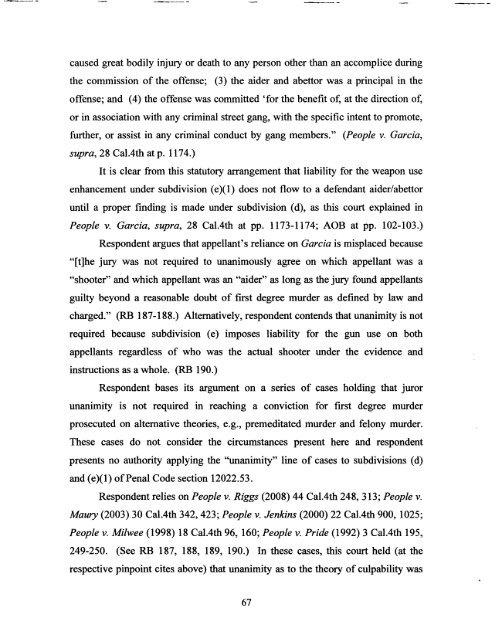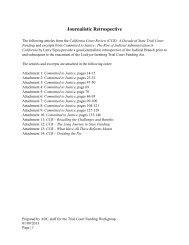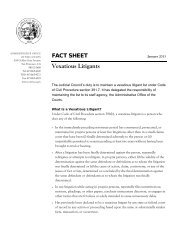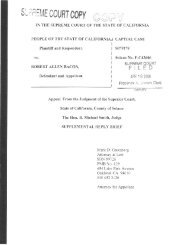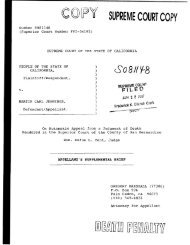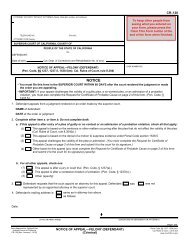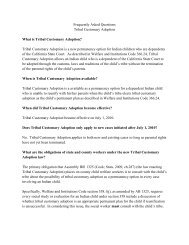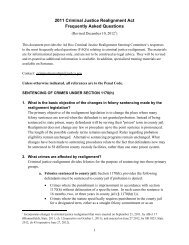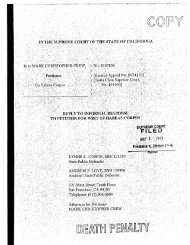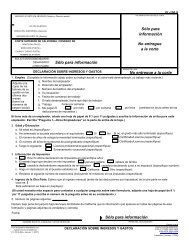Appellant, William Satele, Reply Brief - California Courts - State of ...
Appellant, William Satele, Reply Brief - California Courts - State of ...
Appellant, William Satele, Reply Brief - California Courts - State of ...
Create successful ePaper yourself
Turn your PDF publications into a flip-book with our unique Google optimized e-Paper software.
caused great bodily injury or death to any person other than an accomplice during<br />
the commission <strong>of</strong> the <strong>of</strong>fense; (3) the aider and abettor was a principal in the<br />
<strong>of</strong>fense; and (4) the <strong>of</strong>fense was committed 'for the benefit <strong>of</strong>, at the direction <strong>of</strong>,<br />
or in association with any criminal street gang, with the specific intent to promote,<br />
further, or assist in any criminal conduct by gang members." (People v. Garcia,<br />
supra, 28 Ca1.4th at p. 1174.)<br />
It is clear from this statutory arrangement that liability for the weapon use<br />
enhancement under subdivision (e)(1) does not flow to a defendant aider/abettor<br />
until a proper finding is made under subdivision (d), as this court explained in<br />
People v. Garcia, supra, 28 Ca1.4th at pp. 1173-1174; AOB at pp. 102-103.)<br />
Respondent argues that appellant's reliance on Garcia is misplaced because<br />
"[t]he jury was not required to unanimously agree on which appellant was a<br />
"shooter" and which appellant was an "aider" as long as the jury found appellants<br />
guilty beyond a reasonable doubt <strong>of</strong> first degree murder as defined by law and<br />
charged." (RB 187-188.) Alternatively, respondent contends that unanimity is not<br />
required because subdivision (e) imposes liability for the gun use on both<br />
appellants regardless <strong>of</strong> who was the actual shooter under the evidence and<br />
instructions as a whole. (RB 190.)<br />
Respondent bases its argument on a series <strong>of</strong> cases holding that juror<br />
unanimity is not required in reaching a conviction for first degree murder<br />
prosecuted on alternative theories, e.g., premeditated murder and felony murder.<br />
These cases do not consider the circumstances present here and respondent<br />
presents no authority applying the "unanimity" line <strong>of</strong> cases to subdivisions (d)<br />
and (e)(1) <strong>of</strong>Penal Code section 12022.53.<br />
Respondent relies on People v. Riggs (2008) 44 Ca1.4th 248, 313; People v.<br />
Maury (2003) 30 Ca1.4th 342, 423; People v. Jenkins (2000) 22 Ca1.4th 900, 1025;<br />
People v. Milwee (1998) 18 Ca1.4th 96, 160; People v. Pride (1992) 3 Ca1.4th 195,<br />
249-250. (See RB 187, 188, 189, 190.) In these cases, this court held (at the<br />
respective pinpoint cites above) that unanimity as to the theory <strong>of</strong> culpability was<br />
67


